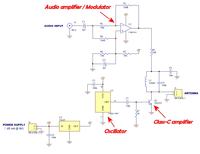Eshal
Advanced Member level 1
- Joined
- Aug 29, 2012
- Messages
- 470
- Helped
- 16
- Reputation
- 32
- Reaction score
- 15
- Trophy points
- 1,298
- Location
- Nowhere :)
- Activity points
- 5,149
Hi!
I thought to design low level AM transmitter on my own. This is what I am doing first time in my life. I have some question and need your help guys and gals.
Q) What should be main sections in order to design low level AM transmitter?
Can my transmitter be consist of oscillator section, modulator section and RF amplifier section, is it OK?
Q) For low level, how much DC supply should I use?
9volts are OK for this or not?
Q) Where should I start my designing?
Should I design oscillator first or start from antenna?
Regards,
Cute Princess
I thought to design low level AM transmitter on my own. This is what I am doing first time in my life. I have some question and need your help guys and gals.
Q) What should be main sections in order to design low level AM transmitter?
Can my transmitter be consist of oscillator section, modulator section and RF amplifier section, is it OK?
Q) For low level, how much DC supply should I use?
9volts are OK for this or not?
Q) Where should I start my designing?
Should I design oscillator first or start from antenna?
Regards,
Cute Princess
